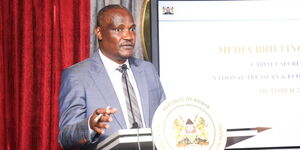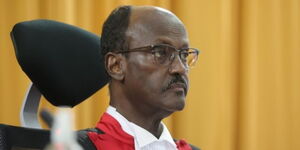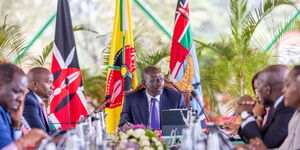Kenya is seeking realistic targets in a new programme with the International Monetary Fund, according to Prime Cabinet Secretary Musalia Mudavadi. This is particularly in light of the anti-Finance Bill June to July skirmishes witnessed in the country and the recent tariffs imposed by United States President Donald Trump.
While speaking in an interview with Bloomberg on Wednesday, Mudavadi revealed that the government will soon start talks and probably conclude a deal by November. However, details of the potential deal remain scant. What has emerged is that the government intends to have finalised the deal by November this year, to cover any budgetary shortfalls.
The latest comes after Kenya and the IMF prematurely terminated a $3.6 billion (Ksh466.1B) deal, resulting in the state forgoing $850 million (Ksh110B) in potential funds. As per the PCS, a new deal would allow President William Ruto’s administration the opportunity to set its own agenda and targets.
“Some of the targets were extremely steep,” Mudavadi noted of the last programme, adding that they don’t want to see protests triggered by economic pain again. “If you are unrealistic with some of your projections, you end up exerting a lot of pressure on your economy and your people.”
Ruto embarked on an aggressive fiscal consolidation drive after becoming president in 2022. He anchored it on raising taxes on everything from bread to diapers, expecting to generate an additional $2.7 billion (Ksh349.6B) in annual revenue. Nationwide protests followed, however, and forced the president to abandon the measures and reconstitute his cabinet.
“We would want a programme that is realistic, maybe another three-year programme,” Mudavadi asserted.
The deal with the IMF comes at a time when financial security is at high risk. This can mostly be attributed to the heightened geopolitical tensions brought about by Trump’s aggressive tariff push that has sparked a fresh trade conflict with China.
This has made it difficult for emerging countries such as Kenya, whose budget is funded with grants, to raise money. This becomes a factor that the government considers when modelling its financial outlook.
Funding from institutions like the US Agency for International Development (USAID), for instance, may no longer come through after Trump gutted the institution. In Europe, governments are reviewing plans to boost spending on defence given the security situation after Russia’s invasion of Ukraine and slash aid.
“We have to come to terms and discuss these new realities as we negotiate the new programme,” Mudavadi said. “We would have to be very realistic based on the numbers that we have as a country to be able to project and show the kind of revenue targets that we want to work with going forward.”
Internally, Mudavadi explained the government is pursuing steps to improve efficiency in the use of available resources, including preparing a bill aimed at reducing the cost of public participation in designing development projects.
Currently, the government spends Ksh7 billion ($54 million) on seeking views from Kenyan citizens on any government legislation during the current parliament, which Mudavadi opined should be slashed.
Even so, the government still plans to increase its borrowing to plug a fiscal deficit that is seen at 5.1 per cent of gross domestic product in the period to June 2025, from an earlier estimate of 3.3 per cent.
Ruto is set to head to China on a state visit next week, where his government will seek new funding for projects including extending a Beijing-supported railway to the border with neighbouring Uganda.












